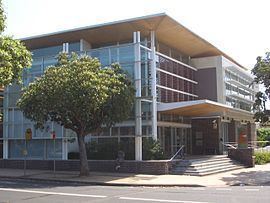Population 6,195 (2011 census) Postal code 2140 | Postcode(s) 2140 | |
 | ||
Homebush is a suburb in the Inner West of Sydney, in the state of New South Wales, Australia. It is located 15 kilometres west of the Sydney central business district, in the local government area of the Municipality of Strathfield. Homebush is located south of Homebush Bay, an inlet of the Parramatta River. and north Homebush West.
Contents
- Map of Homebush NSW 2140 Australia
- History
- Village of Homebush
- Houses
- Transport
- Commercial area
- Schools
- Population
- Residents
- References
Map of Homebush NSW 2140, Australia
History
The first name of settlement at what is today called Homebush was "Liberty Plains". This was a group of grants given to the Colony's first free settlers, who came on the ship "Bellona", in 1793. Most of the original settlers soon departed for agriculturally more attractive places, like the Hawkesbury. One of them, Edward Powell, later returned and established there the Half Way House Inn, on Parramatta Road just west of the creek that now bears his name. Later, when the Great Western Railway line came through there, with a station just behind Powell's inn, the name Homebush was borrowed from the nearest large estate, that of D'Arcy Wentworth. A shopping centre by the name of Homebush has since grown around the railway station of that name. There also used to be a Ford factory in Homebush, which manurfactured the Telstar and the Laser. But the factory closed in 1994.
It is commonly thought that the property and house with the name of Homebush was established and named by the Colony's then assistant surgeon D'Arcy Wentworth. Historian Michael Jones who had been commissioned by Stathfield Council to write the history of that Municipality wrote: "Wentworth is popularly credited with having called the area after his 'home in the bush', although Homebush is also a place in Kent". It is considered unlikely that it was named after the village in Kent as D'Arcy Wentworth was Irish and had no links to the English county. According to local historian David Patrick it wasn’t D'Arcy Wentworth who named Homebush but an earlier grantee on the land – that being the military figure Thomas Laycock. It would appear that after Laycock became mentally ill, following his direct involvement in suppressing the Castle Hill convict rebellion D'Arcy Wentworth became his doctor. It has been reputed that D'Arcy Wentworth either bought the Laycock Homebush Farm from Laycock or, more fancifully, won the property in an unfair game of cards from the ailing Laycock. Wentworth retained Thomas Laycock's name of the property and added to its extent. Laycock had been granted 40 hectares in 1794 and increased this to 318 hectares by 1803 and named it "Home Bush". A notice that Laycock placed in the newspapers about his property "Home Bush" is from before when Wentworth acquired the land from him. Later on, Wentworth acquired more land there himself and the estate had grown to 990 acres by 1811. Homebush once had a very famous racecourse, established by Wentworth.
Village of Homebush
The Village of Homebush estate was a section of the Underwood Estate located to the south of the railway. The land had boundaries of The Crescent, Homebush, Beresford, Coventry and Bridge Roads, was subdivided in 1878. Within the estate, Broughton, Abbotsford and Burlington Roads and Rochester and Meredith Streets were also gazetted. In the December of that year, 381 house blocks were auctioned. By the end of the century many large houses and substantial villas had been built. In the 20th century house construction continued and most blocks had been built on by the end of the 1920s.
Houses
Transport
Homebush railway station is the terminus of all stations services on the Airport, Inner West & South Line of the Sydney Trains network. Parramatta Road and the M4 Western Motorway are the main arterial roads passing through the suburb.
Commercial area
Homebush has a small row of shops along Rochester Street, opposite Homebush Public School. These shops extend to The Crescent, oppositeHomebush railway station. Many more shops sprang up along Parramatta Road in the past. However these are mostly now shut or abandoned-looking in common with other parts of Parramatta Road, a condition attributed to increased congestion and lack of parking. At least for the time being car sales yards continue to flourish along Parramatta Road but this main artery through Homebush has now been re-zoned high density by Strathfield Council, such that highrise can be expected to appear all along it in future.
Schools
Population
At the 2011 census, there were 6,195 residents in Homebush. The majority of people are immigrants, with the largest foreign countries of birth being India 11.8%, China 9.4%, Korea, Republic of (South) 8.1%, Sri Lanka 7.0% and Nepal 2.0%. Most people spoke a language other than English at home. Languages spoken at home included Korean 9.8%, Tamil 9.5%, Mandarin 8.4%, Cantonese 5.7% and Hindi 3.1%. The top religious affiliations were Catholic 21.9%, Hinduism 20.5% and No Religion 15.2%.
Residents
The following were either born or have lived at some time in the suburb of Homebush:
